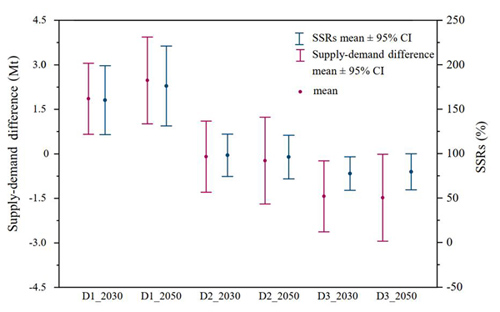Future Unbalanced-trends of Grain Supply and Demand on the Tibetan Plateau
The Tibetan Plateau (TP) is an “ecological security barrier” for China, and the balance of grain supply and demand, and the high-quality development of agriculture and animal husbandry within this region are related to the security of the frontier and ecosystem of China. Forecasting the future self-sufficiency ratio of the TP can help prevent potential food risks and realize the sustainable development of this ecologically fragile area.
Prof. SHI Wenjiao’s team at the Institute of Geographic Sciences and Natural Resources Research (IGSNRR) of the Chinese Academy of Sciences (CAS) found that the staple grain on the TP will be sufficient with more than 150% self-sufficiency ratio (SSR) on average, but neither the total amount of grains (including staple and feed grains) nor the balance of dietary grain goals set for 2030 and 2050 respectively shall be achieved. This study was published in Journal of Cleaner Production.
The researchers considered four grain supply scenarios (including scenarios of resource and input constraints, general natural disasters, extreme natural disasters, and climate change) and three demand scenarios (including scenarios of the staple, total, and balanced dietary grains) to forecast the future grain supply and demand on the TP.
Ding Rui, a graduate student under the guidance of SHI Wenjiao, analyzed the future patterns of grain self-sufficiency on the TP and compared the SSR differences between the future and current status under different scenarios.
The results indicated that although climate change has limited positive effects, it can slow down the decline of SSRs in some counties in western Sichuan and southern Tibet to some extent. Extreme natural disasters have a greater negative impact on the SSR, which will increase the proportion of non-self-sufficient counties by 11%–16% compared with the base case.
These findings would help implement more spatially targeted agricultural adaptations to cope with the impacts of climate change on the agro-ecosystem of the Tibetan Plateau and hope to provide support for policymakers for future agricultural layouts on the TP.
 |
|
Figure: Intervals of grain supply-demand difference and SSRs under different demand scenarios (Image by SHI Wenjiao) |
Related references:
Ding Rui, Shi Wenjiao*, Lu Changhe, et al. Future unbalanced-trends of grain supply and demand on the Tibetan Plateau. Journal of Cleaner Production, 2022: 132993.
Ding Rui, Shi Wenjiao*, Contributions of climate change to cereal yields in Tibet, 1993–2017. Journal of Geographical Sciences, 2022, 32(1): 101-116.
Shi Wenjiao *, Lu Changhe, Shi Xiaoli, et al. Patterns and trends in grain self-sufficiency on the Tibetan Plateau during 1985–2016. Journal of Geographical Sciences, 2020, 30(10): 1590-1602.Download attachments: